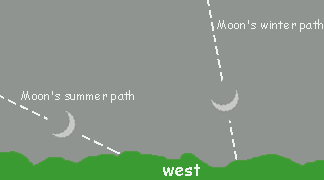
A wet moon (also called a Cheshire moon) is the visual phenomenon when the "horns" of the crescent Moon point up at an angle, away from the horizon, so that the crescent takes on the appearance of a bowl or smile. A wet moon occurs when the crescent Moon is low above the horizon and at a point more or less directly above the Sun's (invisible) position below the horizon. This in turn is determined by the positions of the Moon and Earth in their respective orbits, the inclinations of these orbits relative to one another and to Earth's celestial equator, and the observer's latitude on Earth. Wet moons occur routinely in the tropics (where the Sun and Moon rise and set nearly vertically), but rarely in the polar regions (where the Sun and Moon rise and set at a glancing angle or not at all).
By contrast, a dry moon is one where the crescent of the moon is at any other angle.